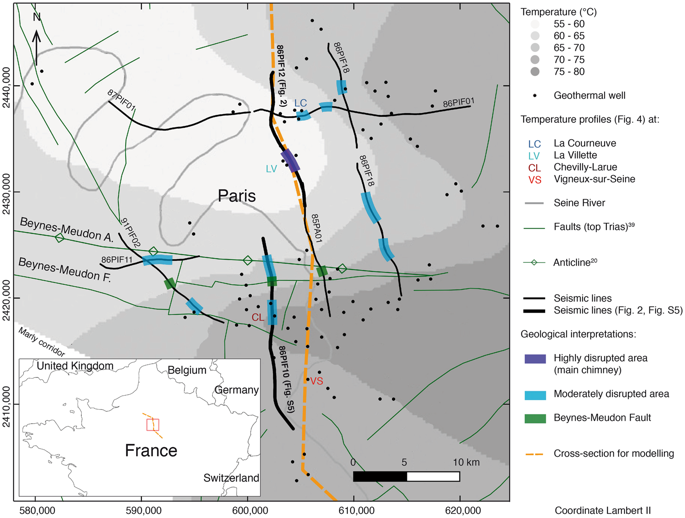Our official English website, www.x-mol.net, welcomes your feedback! (Note: you will need to create a separate account there.)
Thermal and seismic hints for chimney type cross-stratal fluid flow in onshore basins.
Scientific Reports ( IF 4.6 ) Pub Date : 2018-Oct-17 , DOI: 10.1038/s41598-018-33581-x Jacques Dentzer , Dominique Bruel , Matthias Delescluse , Nicolas Chamot-Rooke , Laurent Beccaletto , Simon Lopez , Gabriel Courrioux , Sophie Violette
Scientific Reports ( IF 4.6 ) Pub Date : 2018-Oct-17 , DOI: 10.1038/s41598-018-33581-x Jacques Dentzer , Dominique Bruel , Matthias Delescluse , Nicolas Chamot-Rooke , Laurent Beccaletto , Simon Lopez , Gabriel Courrioux , Sophie Violette

|
When modelling onshore sedimentary basins, modellers generally assume that semi-permeable layers (aquitards) greatly restrict vertical flow between aquifers. Aquitards are therefore considered as confining media and vertical flow is assumed to take place mainly within localised permeable faults, if any. In the offshore context, however, interpretation of seismic data frequently provides evidence of fluid flow between sedimentary layers via structurally disrupted formations (pervasive fractures) recognised as zones of reduced seismic amplitude and generically called "chimneys". Here we show that chimneys are also present onshore, and that they crosscut confining layers. In the Anglo-Paris Basin, seismic data suggest 1 to 2 km wide zones of disrupted seismic signal spatially correlated to a hitherto unexplained major temperature anomaly of 20 °C. When included in geothermal models using a five-order increase in permeabilities with respect to confining layers, we find that fluid flows vertically through aquifers and confining layers, thereby explaining this major temperature anomaly. Despite the importance of their hydrodynamic and thermal impacts, chimneys - less obvious than faults - have been overlooked as fluid flow paths in many onshore sedimentary basins exploited for their resources. This indicates a clear need for better understanding of pervasive flow paths, especially as the resources and properties of basins (i.e. conventional and unconventional hydrocarbons, geothermal potential, CO2 storage, nuclear waste repository, drinking water, etc.) are increasingly being harnessed.
中文翻译:

陆上盆地烟囱型跨地层流体流动的热力和地震提示。
在对陆上沉积盆地进行建模时,建模者通常会假设半渗透层(阿奎塔德)极大地限制了含水层之间的垂直流动。因此,将无水古怪视为封闭介质,并且假定垂直流主要发生在局部渗透性断层(如果有)中。但是,在海上环境中,地震数据的解释经常通过结构破坏的地层(普遍的裂缝)提供沉积层之间流体流动的证据,这些地层被认为是地震振幅减小的区域,通常被称为“烟囱”。在这里,我们表明烟囱也存在于陆上,并且它们切入限制层。在盎格鲁-巴黎盆地,地震数据表明,被破坏的地震信号的1至2 km宽的区域在空间上与迄今无法解释的20°C的主要温度异常有关。当包含在使用相对于密闭层渗透率增加五次的地热模型中时,我们发现流体垂直流过含水层和密闭层,从而解释了这一主要的温度异常。尽管烟囱的水动力和热影响很重要,但烟囱(比断层还不那么明显)已被人们忽视,因为许多陆上沉积盆地中为获取资源而开发的流体流动路径。这表明显然需要更好地了解普遍的流动路径,尤其是盆地的资源和性质(即常规和非常规碳氢化合物,地热潜力,CO 当包含在使用相对于密闭层渗透率增加五次的地热模型中时,我们发现流体垂直流过含水层和密闭层,从而解释了这一主要的温度异常。尽管烟囱的水动力和热影响很重要,但烟囱(比断层还不那么明显)已被人们忽视,因为许多陆上沉积盆地中为获取资源而开发的流体流动路径。这表明显然需要更好地了解普遍的流动路径,尤其是盆地的资源和性质(即常规和非常规碳氢化合物,地热潜力,CO 当包含在使用相对于密闭层渗透率增加五次的地热模型中时,我们发现流体垂直流过含水层和密闭层,从而解释了这一主要的温度异常。尽管烟囱的水动力和热影响很重要,但烟囱(比断层还不那么明显)已被人们忽视,因为许多陆上沉积盆地中为获取资源而开发的流体流动路径。这表明显然需要更好地了解普遍的流动路径,尤其是盆地的资源和性质(即常规和非常规碳氢化合物,地热潜力,CO 尽管烟囱的水动力和热影响很重要,但烟囱(比断层还不那么明显)已被人们忽视,因为许多陆上沉积盆地中为获取资源而开发的流体流动路径。这表明显然需要更好地了解普遍的流动路径,尤其是盆地的资源和性质(即常规和非常规碳氢化合物,地热潜力,CO 尽管烟囱的水动力和热影响很重要,但烟囱(比断层还不那么明显)已被人们忽视,因为许多陆上沉积盆地中为获取资源而开发的流体流动路径。这表明显然需要更好地了解普遍的流动路径,尤其是盆地的资源和性质(即常规和非常规碳氢化合物,地热潜力,CO2储存,核废料储存库,饮用水等)的利用越来越多。
更新日期:2018-10-17
中文翻译:

陆上盆地烟囱型跨地层流体流动的热力和地震提示。
在对陆上沉积盆地进行建模时,建模者通常会假设半渗透层(阿奎塔德)极大地限制了含水层之间的垂直流动。因此,将无水古怪视为封闭介质,并且假定垂直流主要发生在局部渗透性断层(如果有)中。但是,在海上环境中,地震数据的解释经常通过结构破坏的地层(普遍的裂缝)提供沉积层之间流体流动的证据,这些地层被认为是地震振幅减小的区域,通常被称为“烟囱”。在这里,我们表明烟囱也存在于陆上,并且它们切入限制层。在盎格鲁-巴黎盆地,地震数据表明,被破坏的地震信号的1至2 km宽的区域在空间上与迄今无法解释的20°C的主要温度异常有关。当包含在使用相对于密闭层渗透率增加五次的地热模型中时,我们发现流体垂直流过含水层和密闭层,从而解释了这一主要的温度异常。尽管烟囱的水动力和热影响很重要,但烟囱(比断层还不那么明显)已被人们忽视,因为许多陆上沉积盆地中为获取资源而开发的流体流动路径。这表明显然需要更好地了解普遍的流动路径,尤其是盆地的资源和性质(即常规和非常规碳氢化合物,地热潜力,CO 当包含在使用相对于密闭层渗透率增加五次的地热模型中时,我们发现流体垂直流过含水层和密闭层,从而解释了这一主要的温度异常。尽管烟囱的水动力和热影响很重要,但烟囱(比断层还不那么明显)已被人们忽视,因为许多陆上沉积盆地中为获取资源而开发的流体流动路径。这表明显然需要更好地了解普遍的流动路径,尤其是盆地的资源和性质(即常规和非常规碳氢化合物,地热潜力,CO 当包含在使用相对于密闭层渗透率增加五次的地热模型中时,我们发现流体垂直流过含水层和密闭层,从而解释了这一主要的温度异常。尽管烟囱的水动力和热影响很重要,但烟囱(比断层还不那么明显)已被人们忽视,因为许多陆上沉积盆地中为获取资源而开发的流体流动路径。这表明显然需要更好地了解普遍的流动路径,尤其是盆地的资源和性质(即常规和非常规碳氢化合物,地热潜力,CO 尽管烟囱的水动力和热影响很重要,但烟囱(比断层还不那么明显)已被人们忽视,因为许多陆上沉积盆地中为获取资源而开发的流体流动路径。这表明显然需要更好地了解普遍的流动路径,尤其是盆地的资源和性质(即常规和非常规碳氢化合物,地热潜力,CO 尽管烟囱的水动力和热影响很重要,但烟囱(比断层还不那么明显)已被人们忽视,因为许多陆上沉积盆地中为获取资源而开发的流体流动路径。这表明显然需要更好地了解普遍的流动路径,尤其是盆地的资源和性质(即常规和非常规碳氢化合物,地热潜力,CO2储存,核废料储存库,饮用水等)的利用越来越多。



























 京公网安备 11010802027423号
京公网安备 11010802027423号